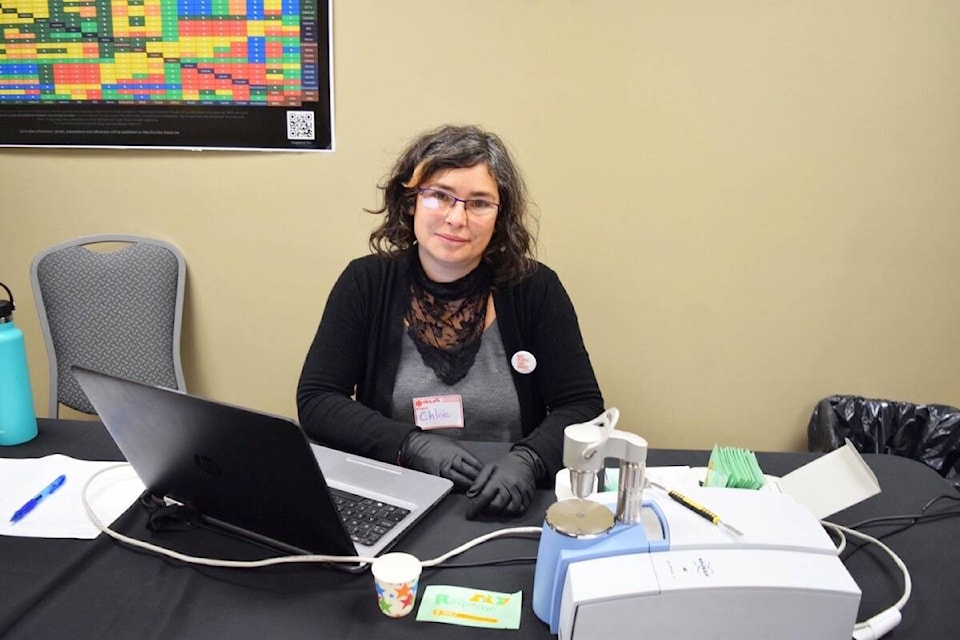by Amber Streukens
ANKORS harm reduction peer navigator
Responding to concerns about a substance tested at ANKORS in the days leading up to New Year’s Eve, Nelson area community members and businesses stepped up to share information and access to harm reduction. These community partnerships are imperative to the success of harm reduction initiatives and the safety of our community members. This type of creative, responsive community partnership is at the root of how ANKORS Drug Checking services came to be.
Beginning in 2003, ANKORS first provided drug checking and other sexual health and harm reduction services to festival-goers at Shambhala Music Festival. This program has expanded over the years to support other music festivals and events, and to offer drug checking in communities throughout the West Kootenay Boundary region. Modern technology enables us to detect a wider variety of substances, and to report the contents of a drug sample with greater accuracy.
ANKORS’ Drug Checking Program employs an Fourier-transform infrared spectrometer (FTIR), which can rapidly analyze substances to detect the main active ingredient as well as any cutting agents that may be present. Additionally, ANKORS utilizes a confirmatory testing service in Vancouver for cases where a substance is considered to be highly concerning, or requires more detailed analysis. The FTIR spectrometer is able to detect common cuts and buffs and known substances with great accuracy. However, ongoing changes in the drug supply do pose a challenge, as the technology relies on reference libraries of data.
Much of the risk associated with the illicit drug supply is due to contamination and high variability. Knowing what is in a substance is the first step to reducing harm. According to Amelia Martzke, ANKORS Drug Checking Program co-ordinator, “Drug checking acts as a gateway to other services. It provides a simple point of contact, some engagement with harm reduction services and safer substance use, and through that we can recognize other supports or referrals that may be helpful or needed.”
Quite often individuals bring in samples for testing and are relieved to find that their substance is what they thought it was, assuming that it is “safe.” This presents an important opportunity for dialogue around the inherent risks associated with substance use, and strategies to reduce harm and increase wellness.
Speaking with Amelia about trends in drug checking results, such as the normalization of fentanyl in the illicit opioid supply, she shared that she is no longer surprised to see benzodiazepine-positive opioid samples. This is a concerning trend mainly because benzodiazepine overdose cannot be reversed with Naloxone and has the potential to cause more complex overdose events, in addition to the myriad of health challenges associated with benzodiazepine dependence or withdrawal.
Because benzodiazepine contamination is becoming more and more common, we are no longer alerting the way we once did. Drug alert messaging in a constantly changing environment poses inherent challenges. The thresholds of normal contamination shift. Just as the presence of fentanyl in an opioid 10 years ago would have been alarming but is now expected, the presence of benzodiazepines in the illicit opioid supply is becoming so commonplace that alerts of this nature are becoming less relevant.
However, according to Amelia, despite the increasing presence of benzodiazepines in the drug supply, we cannot yet say this is “the norm” because there is a great amount of variability within the benzodiazepine class of drugs and their effects.
On top of benzodiazepine contamination, the presence of carfentanil (an extraordinarily potent opioid) in the drug supply raises concerns. According to the BC Coroners Service, “Carfentanil has been detected in 152 suspected illicit drug toxicity deaths in 2021 (January to October) and 66 deaths in 2020.” In the fall of 2021, ANKORS observed an upsurge of carfentanil in opioid samples, but cannot yet assess whether this is a trend developing in our region or an isolated event.
In the absence of a safe regulated supply of substances that is accessible and appropriate for people who use drugs, one can expect that these contamination trends will continue and evolve, alongside rising rates of illicit drug poisoning deaths.
While we continue to advocate for safe supply and decriminalization, ANKORS is also working to improve access to drug checking in the region. In addition to regular office hours at our 101 Baker St. location in Nelson, we now also offer drug checking every second and fourth Tuesday at The Way Out shelter in Castlegar, every first and third Tuesday at the Gospel Chapel in Grand Forks, and two Wednesdays every month at the Community Inclusion Centre in Trail.
Amelia Martzke is available Mondays and Thursdays at ANKORS in Nelson, and samples can be left during business hours (Monday-Thursday, 9:30 a.m. to 4:30 p.m.). This is a safe, confidential service — we do not need any personal information to check samples, but do ask for appropriate contact information to report results. Fentanyl test strips are also available at ANKORS or the HUB during regular hours, as well as other locations throughout the region. For more information, please contact Amelia at drugcheckankors@gmail.com or ANKORS at 250-505-5506.
